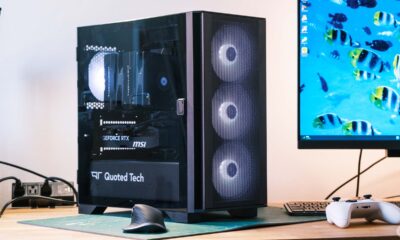Science
EeroQ Develops Novel Quantum Computing Tech with Floating Electrons

Recent advancements in quantum computing technology are being driven by EeroQ, a company that is exploring a novel qubit system utilizing isolated electrons floating on liquid helium. This innovative approach aims to enhance the scalability and efficiency of quantum computers, a field where error rates are decreasing and engineering challenges are becoming more prominent.
Understanding the Technology Behind Floating Electrons
The concept of trapping single electrons above the surface of liquid helium relies on established physical principles. Johannes Pollanen, the chief scientific officer of EeroQ, explained that when a charged particle, such as an electron, approaches the surface of helium, it creates a small positive image charge beneath the liquid. This interaction effectively binds the electron to its own image charge, allowing it to remain suspended above the helium surface.
Maintaining liquid helium requires extremely low temperatures, but it remains in a liquid state up to 4 Kelvin, making it less demanding than other refrigeration methods used in quantum technologies. At these temperatures, the liquid helium also acts as a superfluid, easily flowing through tiny channels etched into silicon chips, which are integral to EeroQ’s experimental setup.
The company’s experiments involve loading the helium surface with electrons using a tungsten filament. This setup enables the formation of electromagnetic traps beneath superconductive plates, allowing the researchers to manipulate the number of trapped electrons. By adjusting the “walls” of the traps, they can control the flow of electrons and isolate them into distinct states: zero, one, or two trapped electrons.
The Future of Qubits in Quantum Computing
The significance of this research lies in its potential to develop a new form of qubit. The trapped single electron is positioned as a promising candidate for mobile qubit architectures. Pollanen highlighted the advantages of using the electron’s spin to store qubit information. This method has been explored previously in silicon impurities and quantum dots, but with challenges in maintaining spin coherence due to complex electronic environments.
In contrast, the isolated electron in EeroQ’s system benefits from a more stable environment, enhancing its spin coherence. “The spin coherence of the electron is going to be fantastic,” Pollanen stated, emphasizing that while no experimental data exists yet, it is unlikely to be inferior to silicon-based systems.
The manufacturing of individual devices using standard CMOS technology allows for the creation of scalable architectures capable of hosting vast numbers of qubits on compact chips. Pollanen noted that these chips would integrate all necessary control circuitry, significantly reducing the wiring required to connect qubits to external systems.
EeroQ’s long-term vision involves utilizing pairs of electrons with opposing spins to encode qubit information. This approach aims to mitigate decoherence, ensuring that if one electron is affected, the other will remain stable. Moving electrons strategically within the chip will be essential for future quantum processors, facilitating the entanglement of qubits for enhanced computational capabilities.
While the path ahead is filled with challenges, the foundational physics and innovative approach behind EeroQ’s technology could pave the way for significant advancements in quantum computing. The company is poised to demonstrate working qubits and rapidly scale their technology, which could transform the landscape of quantum computing.
This research was published in the journal Physical Review X in 2025 and adds to the growing body of knowledge in the quest for practical quantum computing solutions.
-

 Lifestyle1 month ago
Lifestyle1 month agoWinnipeg Celebrates Culinary Creativity During Le Burger Week 2025
-

 Health2 months ago
Health2 months agoMontreal’s Groupe Marcelle Leads Canadian Cosmetic Industry Growth
-

 Science2 months ago
Science2 months agoMicrosoft Confirms U.S. Law Overrules Canadian Data Sovereignty
-

 Education2 months ago
Education2 months agoRed River College Launches New Programs to Address Industry Needs
-

 Technology2 months ago
Technology2 months agoDragon Ball: Sparking! Zero Launching on Switch and Switch 2 This November
-

 Science2 months ago
Science2 months agoTech Innovator Amandipp Singh Transforms Hiring for Disabled
-

 Technology2 months ago
Technology2 months agoGoogle Pixel 10 Pro Fold Specs Unveiled Ahead of Launch
-

 Science2 months ago
Science2 months agoChina’s Wukong Spacesuit Sets New Standard for AI in Space
-

 Technology2 months ago
Technology2 months agoWorld of Warcraft Players Buzz Over 19-Quest Bee Challenge
-

 Science2 months ago
Science2 months agoXi Labs Innovates with New AI Operating System Set for 2025 Launch
-

 Business2 months ago
Business2 months agoDawson City Residents Rally Around Buy Canadian Movement
-

 Business2 months ago
Business2 months agoNew Estimates Reveal ChatGPT-5 Energy Use Could Soar
-

 Technology2 months ago
Technology2 months agoInnovative 140W GaN Travel Adapter Combines Power and Convenience
-

 Technology2 months ago
Technology2 months agoFuture Entertainment Launches DDoD with Gameplay Trailer Showcase
-

 Technology2 months ago
Technology2 months agoGlobal Launch of Ragnarok M: Classic Set for September 3, 2025
-

 Education2 months ago
Education2 months agoAlberta Teachers’ Strike: Potential Impacts on Students and Families
-

 Technology2 months ago
Technology2 months agoNew IDR01 Smart Ring Offers Advanced Sports Tracking for $169
-

 Technology2 months ago
Technology2 months agoArsanesia Unveils Smith’s Chronicles with Steam Page and Trailer
-

 Technology2 months ago
Technology2 months agoHumanoid Robots Compete in Hilarious Debut Games in Beijing
-

 Science2 months ago
Science2 months agoNew Precision Approach to Treating Depression Tailors Care to Patients
-

 Health2 months ago
Health2 months agoGiant Boba and Unique Treats Take Center Stage at Ottawa’s Newest Bubble Tea Shop
-

 Technology2 months ago
Technology2 months agoQuoted Tech Launches Back-to-School Discounts on PCs
-

 Business2 months ago
Business2 months agoBNA Brewing to Open New Bowling Alley in Downtown Penticton
-

 Technology2 months ago
Technology2 months agoDiscover the Relaxing Charm of Tiny Bookshop: A Cozy Gaming Escape










